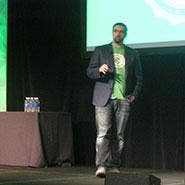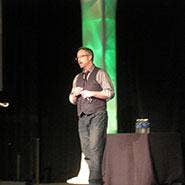CenturyLink Outlines Plans For New Services, New Platform Based On SDN, NFV

CenturyLink is planning a big 2015 push to bring new services to its channel partners as a way to help them better provide telecom and cloud services to their business clients.
The Monroe, La.-based telecom and network services provider also plans to expand on its programmable services backbone, based on the company's software-defined networking capabilities, to make it easier for partners to deliver their own services.
The company detailed its plans during the CenturyLink AllianceEXPO 2015 partner conference held this week in Denver.
[Related: CenturyLink To Partners: Time For Integrated Networking, Cloud, Co-Lo Platform]
Jared Wray, CTO of cloud for CenturyLink, told channel partners that his team, which came to CenturyLink with that company's 2013 acquisition of public cloud services provider Tier 3, was in the past year able to introduce 23 new features, including hyperscale capabilities, a new user interface and integrated managed services that allow fully automated spinning up of services.
"We went from two weeks to 20 minutes to provision a new service," he said.
The work his team did also allowed for a significant drop in pricing for CenturyLink's services, a trend Wray said will continue in 2015. "We have it in our business marketing that we will continue to drop prices," he said.
Wray then offered channel partners a peek at some of the 25-plus new major features CenturyLink plans to introduce in 2015.
Among them are ways to significantly decrease infrastructure deployment times, build on a newly inked relationship with big data and business analytics software developer Pivotal and introduce new solutions from CenturyLink's 2013 acquisition of PaaS provider AppFog, he said.
CenturyLink in 2015 will also roll out new dedicated technical account managers, enterprise-level phone support and advanced notification of new cloud capabilities for the Platform CenturyLink architecture to partners who commit to specific levels of cloud business, he said.
The new TCO (total cost of ownership) tool CenturyLink successfully introduced in 2014 this year will be open-sourced, Wray said. "We want to enable you guys to fully take advantage of it," he said.
Solution providers who partner with CenturyLink on cloud technology can expect access to a number of new services, including public and private cloud services, a new on-boarding engine for helping customers get to the cloud and enhancements to cloud billing APIs to provide full auditing, Wray said. Such partners will find it easier to name their own cloud pricing in 2015, he said.
NEXT: CenturyLink Expands Programmable Services Backbone, Based On SDN And NFV

Also new in 2015 will be new disaster recovery-as-a-service capabilities built on CenturyLink's December acquisition of DataGardens, Wray said.
While CenturyLink already provides disaster recovery services via software bundles, its long-term goal is to integrate the DataGardens disaster- recovery-as-a-service solution into the Platform CenturyLink, he said.
"Disaster recovery will be built in," he said. "We want to make this simpler. ... We believe that by taking it in-house, we will make it easier for you guys."
The Platform CenturyLink Wray mentioned was introduced late last year to bring CenturyLink's networking, cloud, colocation and managed services into an integrated offering.
For 2015, the company plans to use Platform CenturyLink and its foundation based on infrastructure, colocation, networking and managed services to be a disruptive force in the telecom and cloud market, Wray said.
"No one else has this," he said. "IBM is close. They don't have the network [part]. But they have mainframes. If you want to sell mainframes, go see them."
Bill O'Brien, CenturyLink's director of adaptive platforms strategy and development, told solution providers his company is moving to transform its network into a software-defined services backbone as a way to more quickly deploy partner services.
That software-defined networking-based backbone, which O'Brien called the programmable services backbone, was introduced in 2014 in response to customers coming to CenturyLink with VPNs and MPLS routers defined by software on a USB stick and not packaged in big iron. "So we are transforming our network into a massive cloud," he said.
The programmable services backbone includes the infrastructure that will allow network services to be deployed within seconds, O'Brien said.
CenturyLink is using that backbone to develop new customer-premises equipment (CPE) that can be virtualized to bring them directly to customers' offices, he said. Customers can also use it for software-defined networking (SDN) and network functions virtualization (NFV), he said.
"We now have a computational and storage backbone that spans seven countries," he said. "And when we add what Jared [Wray] is talking about, we can do some very interesting things. ... You will be able to deploy your services wherever the customer is."
CenturyLink's programmable services backbone is becoming a unified services delivery fabric that can be deployed over core or metro networks, or with virtualization on customer premises, O'Brien said. "It lets you deploy anything you want that's software-based, anytime and anywhere," he said.
NEXT: CenturyLink Offers Sneak Peek At Upcoming Programmable Services Backbone Capabilities
Looking forward, CenturyLink wants to create a compelling experience where the platform tells customers everything they need to know, O'Brien said.
"What if you could interface with the network like you do with Siri or Google?" he said. "What if the network notified you of upcoming changes? In the past, you had to adapt to the network. We're coming to a time where the network adapts to you."
CenturyLink in 2014 added network-based security and OpenStack capabilities to the programmable services backbone, O'Brien said.
The company in 2015 plans to enhance the backbone with data center cloud integration, new virtual CPE solutions, application performance capabilities and the ability to deploy over third-party clouds, he said. Increased virtualization of such capabilities as WAN optimization and security are expected in 2016, he said.
CenturyLink seems to be unique in its ability to provide an end-to-end platform and total solution, said Aaron Schweers, chief solutions architect at Provision Networks, a Scottsdale, Ariz.-based solution provider and CenturyLink channel partner.
"There's a lot of confusion in the market," Schweers told CRN. "Customers are struggling with piecemeal solutions. Nothing is cohesive. But when Jared [Wray] talked about the ability to automate the integration and support, I can see how the ease of entry and the ease of management will become very attractive to customers."
It's interesting to see a company like CenturyLink actually plan its business with the expectations that prices will fall, said Jeffery Chapman, president of US ACOMM, a Brooklyn Center, Minn.-based communications services provider and CenturyLink channel partner.
"Jared said the company was planning for the price of services to go down," Chapman told CRN. "How many networking businesses plan that? Wireless companies didn't. Companies who provide fiber infrastructure didn't. How many went out of business or were bought out of bankruptcy?"
The kind of capabilities and services being introduced by CenturyLink look interesting, but it's often tough for smaller partners to transition to them, Chapman said.
"We still haven't figured out what it will take to make the transition," he said. "We do a fair amount of health care, and are helping clients get services from the cloud. But they are not moving data there yet. It doesn't mean they won't in the future. But take disaster recovery. It's something they need. But they are also still dealing with the security of their data. That's why they are not looking at disaster recovery-as-a-service."
PUBLISHED JAN. 16, 2015